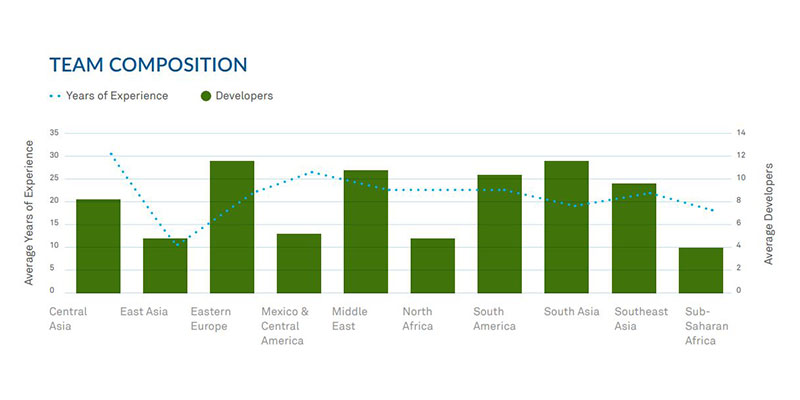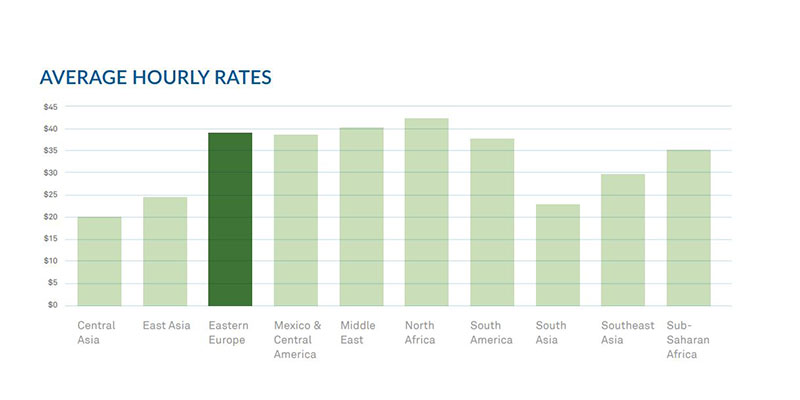Given that the world’s market is now tailored to the development of the IT industry, technology implementation and visibility stay top of the priority in the decision-making of every business, even for companies with a non-tech core value proposition.
In fact, Information Technology and digital transformation act rather as a comprehensive tool for customer engagement, communication and management.
With the application of digital advances at scale, IT outsourcing services are developing at a quick pace, and Offshore Development Center as a branch of IT outsourcing has shown some outstanding advantages.
As many businesses considering Offshore Development Center for their IT implementation, they stumble upon the significant problem of choosing a destination of their ODC.
This article will provide you with insights into the global software marketplace regarding team composition, average pay, and the most popular destinations for IT outsourcing.
Team composition
When it comes to team composition, the two dominant regions are Eastern Europe and South Asia.
In these regions, the clients can get access to a large talent pool of highly experienced engineers. The number of years working in the industry or in any particular domain is a major metric used to assess the industry maturity.

Countries for Offshore Development Center – Team composition
For a vast and demanding industry that requires fast adaption and deep knowledge as IT industry, it is very hard and challenging to call someone an expert, let alone to gain managerial and leadership skills.
Despite the brain drain situation when most experienced engineers move onto more prominent and high-paid regions, Eastern Europe and South Asia can still provide software professionals and experts to the market.
Average Pay
Pricing is one of the significant features to be considered when clients assess their vendors. Although some clients are hesitant with the price-based decision-making, a majority of them deem cost savings the core factor that makes ODC worth investing.
Regarding the average hourly rate, South Asia and Central Asia offer the least of all, with approximately $20/hour and $23/hour, respectively. In contrast, Eastern Europe and North Africa are at a relative disadvantage with an hourly rate of $39/hour, which is about 18% higher than the average price.

Countries for Offshore Development Center – Pricing & Average Pay
In the case of South Asia, the main reason why the price is kept at a relatively low rate is the geographical pricing. Together with a substantial and robust labor force and the governments’ emphasis on the development of IT training, geographical pricing keeps it slow for the labor costs.
In Southern Asia countries, perhaps the most common issue reported by clients from the US and EU is the time zone gaps. In addition, nearly all clients expressed their concerns over the up-side-down working hours (both for them and the vendors). However, these concerns are not major obstacles, as many clients are willing to try and invest in the overhead required.
Remote team pricing can be divided into two groups of Asia and non-Asia. Even though the glaring gap between the price of Asia and the rest of the world has been narrowed down, there is still a fourteen-dollar difference in the average hourly rate.
Technology stack
With Eastern Europe and Asia put onto comparison, we can see distinctive traits of technical specializations.
For Eastern Europe, the talent market is bound to cutting-edge technology with a larger utility of JavaScript, Ruby, Rails and Python. In contrast, for Asia, the revenue-beneficial technologies such as Java or .Net continue to grow with a higher percentage.
With clients demanding the application of new technologies often go for service providers from Eastern European countries, those with long, protracted and complex projects go for Asia countries.
Emerging countries for Offshore Development setup
Asia and Eastern Europe are the two main competitors in the world’s market, with Asia being the more favored destination, in terms of both pricing and technical specializations.
Besides the world-renowned countries for IT outsourcing and offshore development center, there are emerging countries in this industry with a more competitive price range, including:
– Vietnam
As the top emerging destination for IT Outsourcing and Offshore Development Center setup, Vietnam has what it takes to build a fully functional and talented team of developers and tech engineers.
To make a favorable destination for software export. Vietnam is nurturing a large talent pool with 25000 eligible tech engineer graduates every year. These talents are well-trained of the technology stack and work with a competitive price range, making it the most profitable for clients when hiring their tech staff in Vietnam.

Countries for Offshore Development Center – Vietnam
– India
Despite the lowest price on the market, India continues to suffer from the bad reputation of being underqualified and tacky work. However, Japan is projected to receive technical help from Japan in the transition into the new phase of development. With a well-built and complete IT ecosystem, Indian companies will revamp their services.
– China
China is not the country with the lowest price, but the technology fulfillment in this country can satisfy any client.
The technology enhancement in China continues to grow over the past few years, with artificial intelligence and virtual reality have gained substantial success. However, despite the sheer volume of tech engineers, government involvement and subsidiary, China is still a favorite destination for some specific fields and domains.
– The Philippines
The Philippines is becoming more and more popular in the IT outsourcing and Offshore Development Market. In addition to high talent competency, the IT workforce in The Philippines uses English as their native language, which eliminates the language barriers in communication.
- Website: https://www.lotus-qa.com/
- Tel: (+84) 24-6660-7474
- Fanpage: https://www.facebook.com/LotusQualityAssurance

